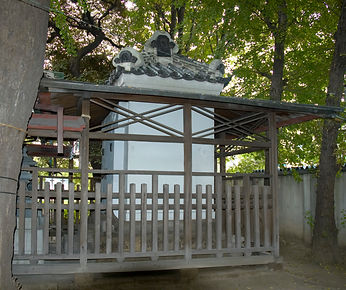普通の外にいくつかの著名な品質を持っている、と畏敬の念を起こさせるあるいかなるビーイングは、カミと呼ばれています。
Nearest station
Senjuōhashi
Keisei Line
Tōkyō-to, Adachi-ku, Senjū-Hashido-chō 25
東京都足立区千住橋戸町25
橋戸稲荷神社
Hashido Inari Jinja
Home page: None
August 30, 2017
Enshrined Deities:
Main
Ukanomitama-mikoto 倉稲魂命
From Merged Shrines
In-ground Shrines:
Inari Jinja 稲荷神社
Earliest mention of: 926
Annual Festival: Nearest Sunday to September 14
Overview
In the roughly eight square kilometre area between the Arakawa and Sumida rivers defined by the Shinarakawa Bridge to the east and the Nishiarai Bridge to the west there are at least 13 shrines. I plan to look at some of them, starting with this one, the Hashido Inari Jinja, and then the Naka-chō Hikawa Jinja.
History
Two foundation dates five centuries apart are given for this shrine, 926 and 1490. The earlier date refers to the construction of a small shrine on a low mound near to a ferry crossing point on the Arakawa (now Sumida) River to service the devotional needs of local settlers and cargo boats plying their trade between the upper Arakawa River and the then fledgling Edo.
1490 seems to have been when Ukanomitama-mikoto was enshrined and a main hall was built. In 1594 the Senjuōhashi (lit. Large Senju Bridge) was built across the Arakawa and in 1597 Senju was officially designated a post station (jushuku), the first from Nihonbashi, on both the Ōshū and Nikkō Highways (kaidō). Almost four centuries later, in 1862, the prayer hall was built.
Description
The current main hall, built like a storehouse with walls covered in mud, is both somewhat unusual and the shrine's main claim to relative fame. On the back of its two front doors are engravings of two kitsune in the kote-e style by Irie Chōhachi. The doors are only opened to public view three times a year, on February 3, May 15 and one other occasion. The photos in the fourth rank below are of replicas added to either side of the hengaku in the prayer hall in 1988.
(Click on images to expand them)













